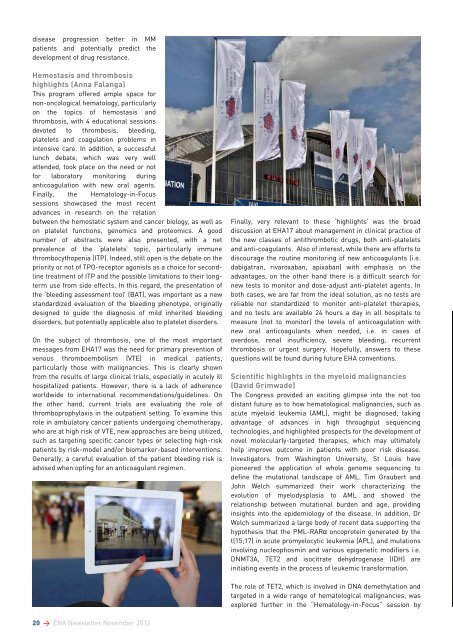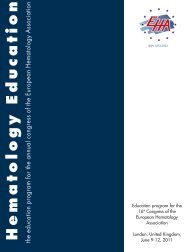Newsletter May 2012 - European Hematology Association
Newsletter May 2012 - European Hematology Association
Newsletter May 2012 - European Hematology Association
You also want an ePaper? Increase the reach of your titles
YUMPU automatically turns print PDFs into web optimized ePapers that Google loves.
disease progression better in MM<br />
patients and potentially predict the<br />
development of drug resistance.<br />
Hemostasis and thrombosis<br />
highlights (Anna Falanga)<br />
This program offered ample space for<br />
non-oncological hematology, particularly<br />
on the topics of hemostasis and<br />
thrombosis, with 4 educational sessions<br />
devoted to thrombosis, bleeding,<br />
platelets and coagulation problems in<br />
intensive care. In addition, a successful<br />
lunch debate, which was very well<br />
attended, took place on the need or not<br />
for laboratory monitoring during<br />
anticoagulation with new oral agents.<br />
Finally, the <strong>Hematology</strong>-in-Focus<br />
sessions showcased the most recent<br />
advances in research on the relation<br />
between the hemostatic system and cancer biology, as well as<br />
on platelet functions, genomics and proteomics. A good<br />
number of abstracts were also presented, with a net<br />
prevalence of the ‘platelets’ topic, particularly immune<br />
thrombocythopenia (ITP). Indeed, still open is the debate on the<br />
priority or not of TPO-receptor agonists as a choice for secondline<br />
treatment of ITP and the possible limitations to their longterm<br />
use from side effects. In this regard, the presentation of<br />
the ‘bleeding assessment tool’ (BAT), was important as a new<br />
standardized evaluation of the bleeding phenotype, originally<br />
designed to guide the diagnosis of mild inherited bleeding<br />
disorders, but potentially applicable also to platelet disorders.<br />
On the subject of thrombosis, one of the most important<br />
messages from EHA17 was the need for primary prevention of<br />
venous thromboembolism (VTE) in medical patients,<br />
particularly those with malignancies. This is clearly shown<br />
from the results of large clinical trials, especially in acutely ill<br />
hospitalized patients. However, there is a lack of adherence<br />
worldwide to international recommendations/guidelines. On<br />
the other hand, current trials are evaluating the role of<br />
thromboprophylaxis in the outpatient setting. To examine this<br />
role in ambulatory cancer patients undergoing chemotherapy,<br />
who are at high risk of VTE, new approaches are being utilized,<br />
such as targeting specific cancer types or selecting high-risk<br />
patients by risk-model and/or biomarker-based interventions.<br />
Generally, a careful evaluation of the patient bleeding risk is<br />
advised when opting for an anticoagulant regimen.<br />
Finally, very relevant to these ‘highlights’ was the broad<br />
discussion at EHA17 about management in clinical practice of<br />
the new classes of antithrombotic drugs, both anti-platelets<br />
and anti-coagulants. Also of interest, while there are efforts to<br />
discourage the routine monitoring of new anticoagulants (i.e.<br />
dabigatran, rivaroxaban, apixaban) with emphasis on the<br />
advantages, on the other hand there is a difficult search for<br />
new tests to monitor and dose-adjust anti-platelet agents. In<br />
both cases, we are far from the ideal solution, as no tests are<br />
reliable nor standardized to monitor anti-platelet therapies,<br />
and no tests are available 24 hours a day in all hospitals to<br />
measure (not to monitor) the levels of anticoagulation with<br />
new oral anticoagulants when needed, i.e. in cases of<br />
overdose, renal insufficiency, severe bleeding, recurrent<br />
thrombosis or urgent surgery. Hopefully, answers to these<br />
questions will be found during future EHA conventions.<br />
Scientific highlights in the myeloid malignancies<br />
(David Grimwade)<br />
The Congress provided an exciting glimpse into the not too<br />
distant future as to how hematological malignancies, such as<br />
acute myeloid leukemia (AML), might be diagnosed, taking<br />
advantage of advances in high throughput sequencing<br />
technologies, and highlighted prospects for the development of<br />
novel molecularly-targeted therapies, which may ultimately<br />
help improve outcome in patients with poor risk disease.<br />
Investigators from Washington University, St Louis have<br />
pioneered the application of whole genome sequencing to<br />
define the mutational landscape of AML. Tim Graubert and<br />
John Welch summarized their work characterizing the<br />
evolution of myelodysplasia to AML and showed the<br />
relationship between mutational burden and age, providing<br />
insights into the epidemiology of the disease. In addition, Dr<br />
Welch summarized a large body of recent data supporting the<br />
hypothesis that the PML-RARα oncoprotein generated by the<br />
t(15;17) in acute promyelocytic leukemia (APL), and mutations<br />
involving nucleophosmin and various epigenetic modifiers i.e.<br />
DNMT3A, TET2 and isocitrate dehydrogenase (IDH) are<br />
initiating events in the process of leukemic transformation.<br />
The role of TET2, which is involved in DNA demethylation and<br />
targeted in a wide range of hematological malignancies, was<br />
explored further in the “<strong>Hematology</strong>-in-Focus” session by<br />
Olivier Bernard and Henk Stunnenberg. Further insights into<br />
the biology of myeloid malignancies were provided in the<br />
Presidential Symposium. Raphael Ceccaldi and colleagues<br />
presented new data showing that the bone marrow failure that<br />
characterizes the pre-leukemic condition Fanconi Anemia,<br />
relates to an exaggerated p53/p21 DNA damage response.<br />
Equally of interest, Bert van der Reijden and colleagues<br />
provided evidence that the transcription factor GFI1 is a direct<br />
target of the RUNX1-RUNX1T1 fusion, showing that this is<br />
important for the development of the t(8;21) subtype of Core<br />
Binding Factor (CBF) leukemia.<br />
The merits of defining mechanisms, by which chimeric<br />
oncoproteins, resulting from leukemia associated translocations,<br />
transform hematopoietic progenitors to inform<br />
development of novel treatment approaches, were exemplified<br />
in work presented by Brian Huntly and Tim Somervaille in<br />
relation to leukemias involving MLL fusions. Proof of principle<br />
for the therapeutic potential of agents that specifically target<br />
the underlying leukemogenic lesion has already been provided<br />
by the use of combined ATRA and arsenic trioxide therapy to<br />
cure patients with APL. This success story prompted a lively<br />
lunchtime debate between Alan Burnett and Eli Estey, as to<br />
whether chemotherapy has now become redundant in this<br />
subset of leukemia. The 17 th Congress of EHA certainly gave<br />
cause for optimism that this treatment paradigm could be<br />
extended to other molecularly-defined subsets of AML in the<br />
future.<br />
Delegate survey<br />
The results of the survey amongst delegates after the congress<br />
(over a thousand responses were counted) have been<br />
thoroughly examined by the EHA Board and the EHA Executive<br />
Office. It was interesting to note that the main reason for<br />
attending the congress is the invited speaker program. The<br />
quality of the chairs and speakers was scored “good” to<br />
“excellent” and the same applies to the session formats, as<br />
well as the abstract program. Only 25% of the respondents<br />
downloaded the Congress mobile app, but those who did, rated<br />
the contents as “good” to “excellent”.<br />
Finally, 82% of the respondents indicate they will attend next<br />
year’s meeting, which is very encouraging!<br />
Upcoming congress(es)<br />
EHA considers the 17 th Congress as another highlight of the<br />
year and we hope you feel the same way after attending. If you<br />
did not attend, we do hope to see you in Stockholm next year.<br />
Preparations are in full swing and everyone is welcome to<br />
submit abstracts and register online from January 1, 2013.<br />
PS: Do you have any idea where the 20 th Congress will take<br />
place? Follow us on Twitter to find out.<br />
As chair of the Scientific Program Committee of the 17 th Congress, Tony Green presented the facts and figures of the program to the press.<br />
20 > EHA <strong>Newsletter</strong> November <strong>2012</strong> EHA <strong>Newsletter</strong> November <strong>2012</strong> > 21












